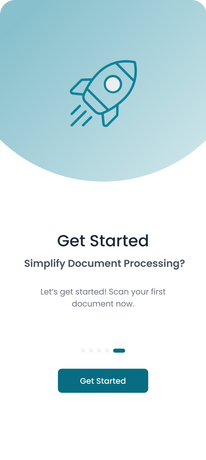
1. Project Overview
Problem Statement:
The existing manual process of entering property evidence into the system was time-consuming, error-prone, and inconsistent. There was no efficient way to extract or edit scanned data digitally. Additionally, user management lacked centralized control, making permission handling, audit logging, and onboarding difficult.
Solution:
We developed:
-
A mobile app for evidence scanning using Robotic Process Automation (RPA), allowing users to scan, extract, edit, and submit documents seamlessly.
-
A web-based admin portal for streamlined user management with capabilities for role assignment, authentication, audit logging, and permission control.
2. My Role
Role: UX Designer
Responsibilities:
-
UX Designer (Mobile + Web)
-
Collaborated with product managers, developers, and stakeholders
-
Led end-to-end UX design for both platforms—from research to high-fidelity mockups
3. Research & Discovery
-
Conducted stakeholder interviews to understand pain points in the evidence submission process and admin controls.
-
Shadowed users in the field to observe the document scanning and data entry workflow.
-
Audited current tools for user management and identified inconsistencies and security gaps.






4. Design Process
-
Information Architecture: Mapped the workflows for evidence scanning/editing and admin user actions.
-
Wireframes: Created low-fidelity wireframes to visualize user journey and page hierarchy.
-
Prototypes: Designed interactive prototypes in Figma for testing and stakeholder feedback.
-
Usability Testing: Conducted usability tests with internal teams and revised flows based on feedback.
6. Web-based Admin Portal
7. Scanning Flow
-
User Login
-
User opens the app and logs in.
-
-
Document Scanning
-
User uses the mobile camera to scan a property evidence document.
-
-
Data Extraction
-
System uses OCR and RPA to auto-extract key information from the scanned document.
-
-
Data Preview & Edit
-
Extracted data is shown in an editable format. User can review and correct fields as needed.
-
-
Submit to System
-
Once verified, the user submits the document. The data is entered into the main system.
-
-
Audit Log Recording
-
All user actions (scan, edit, submit) are recorded and stored for audit, visible via the admin portal.
-
.
Pain Point Addressed:
-
Manual data entry was slow and led to errors
→ Solution: Introduced automated data extraction using OCR & RPA. -
Users couldn’t verify or trust auto-extracted data
→ Solution: Added editable preview with confidence indicators and inline editing. -
Submission flow lacked clarity and feedback
→ Solution: Designed a simple one-tap submit action with confirmation feedback. -
No traceability or action history was available
→ Solution: Implemented a complete audit log system with searchable user actions.
8. Challenges & Solutions
🚧 Challenge: Inconsistent document formats made data extraction unreliable.
✅ Solution: Collaborated with developers to test multiple OCR models and used fallback options.
🚧 Challenge: Users struggled to trust auto-extracted data.
✅ Solution: Added visual indicators for confidence level & allowed inline editing.
🚧 Challenge: Complex permission rules confused admin users.
✅ Solution: Created predefined role templates and a simple toggle system.
9. Impact & Results
-
70% reduction in evidence data entry time
-
Increased data accuracy due to inline editing and smart field detection
-
Admin management time cut by 50% due to intuitive dashboard and search tools
-
Improved compliance and traceability with full audit logs and user activity history
10. Conclusion & Learnings
-
Small design decisions (like adding inline edit buttons or progress indicators) can greatly increase user trust.
-
Admin tools must balance power and simplicity—clear roles, intuitive permission structures, and clear feedback are key.
-
Designing for systems like RPA taught me the importance of designing around the tech.

















